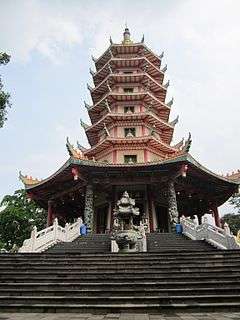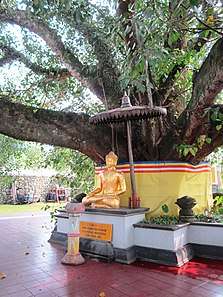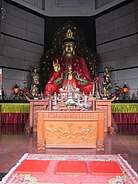Vihara Buddhagaya Watugong
Vihara Buddhagaya Watugong also known as Vihara Buddhagaya (in English Vihara Bodh Gaya Watugong and Vihara Bodh Gaya respectively) is a Buddhist temple located in Semarang, Indonesia.
| Vihara Buddhagaya Watugong | |
|---|---|
 Pagoda Avalokitesvara, Bodh Gaya Watugong | |

| |
| General information | |
| Type | Religious Temple (Building) |
| Architectural style | Chinese Oriental & Thailand |
| Location | |
| Address | Perintis Kemerdekaan Road, Banyumanik, Semarang Central Java |
| Coordinates | 7°05′10″S 110°24′32″E |
| Construction started | October 19th 1955 |
Layout
The precise location is in Pudakpayung, Banyumanik in front of the Kodam IV/Diponegoro military base. Vihara Bodh Gaya Watugong cultural complex consists of two main buildings/temples: Pagoda Avalokitesvara and Pagoda Dhammasala. It is surrounded by smaller temples and other buildings. The two temples incorporate classic oriental design and architecture.
Other buildings include the Watugong rock, Borobudur plaza, Kuti Meditasi, Kuti Bhikku, public reading park and library, Buddha Parinibana, Abhaya Mudra and the Bodhi tree.
The tallest tower stands at 45 meters, the tallest pagoda tower in Indonesia. A five-meter statue of the goddess Guanyin is located in one of the towers. This complex was formerly used exclusively as a Buddhist religious temple. With its classical oriental design and architectural heritage, the Vihara Bodh Gaya evolved to become a cultural and heritage tourism site by the local populace and the government of Semarang.
History

The Watugong complex stretches back to the Majapahit. Buddhism was then the official religion. With the fall of Majapahit empire and the spread of Islam, the practice of Buddhism fell drastically. Buddhism reemerged 500 years later. The first attempt to evangelize Buddhism came in the Dutch colonial era through Ashin Jinarakkhita with the encouragement of Narada Maha Thera.
In 1955, Semarang/Chinese landlord Goei Thwan Ling was so impressed by Ashin Jinarakkhita at the Vesak 2549 celebrations at Borobudur temple that he donated some of his land to build the temple complex Vihara Bodh Gaya. The temple complex was devoted to teaching Buddhism and the development of the religion.
By the end of 1955, Ashin Jinarakkhita maintained a permentant residence at the Bodh Gaya temple complex. He dedicated his life to the complex.[1]
In February 2001, the complex underwent major renovations under Sangha Theravada, after eight years of neglect. Renovations started with the Dhammasala building which finished on November 3rd, 2002. The building was reopened by the Central Java Governor at the time of H. Mardiyanto. Other buildings followed. The Pagoda Avalokitesvara started renovations in November 2004 and reopened on July 14th, 2005.[2]
Dhammasala Temple
The Dhammasala temple is one of the main buildings. It is located on the right side of the vihara. A two story building with the first floor used as a function hall and the second floor used for prayer, hosting a statue of Buddha. It has a total capacity of 1000 pilgrims. The staircase to the prayer hall is outside the building. No interior staircase exists.
The building attracts tourists mainly because of the oriental architecture that contrasts with traditional Javanese pendhapa architecture surrounding the complex.
Another centerpiece is a 5-meter brass statue of sitting Buddha which resembles the statue at Candi Mendut. Other functions are organizational, such as the annual local or international Buddhist convention managed by Vihara Bodh Gaya Watugong foundation.
Pagoda Avalokitesvara


Pagoda Avalokitesvara (Pagoda Guanyin) is on the main path of the complex. Construction started in August 2004 and opened by July 14, 2005. This building is the tallest pagoda tower in Indonesia at 45 meters. The architecture follows the design of the main temple and represents Metta Karuna or love of Buddha.
The building used concrete for the structure and brick for the walls. The outer layer is painted in red to represent happiness or luck. This tower has seven levels with thirty statues of worship inside and a five-meter Avalokitesvara Boddhisatva statue surrounded by fruits and flowers as worship offerings.
Outside the perimeter of the pagoda are five Guanyin statues and one of We Po. The building has eight sides and is called Pat Kwa.
Watugong
The name Watugong derives from a natural rock formation with a gong-like shape, thus the name watu or rock and gong. This rock is unique because it naturally formed into a gong-like shape.
Bodh Gaya Foundation
The Bodh Gaya Foundation was established on October 19, 1955 to manage the day-to-day operations of the complex, and is responsible for maintenance and preservation.